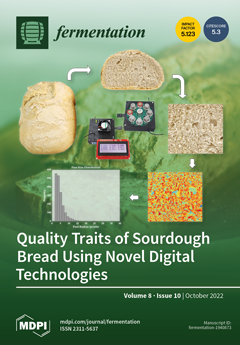The aim of this study was to evaluate the influence of supplemental granulated cane sugar (GCS) levels (0, 13.3, 26.6, and 39.9% on a dry matter basis) in a steam-flaked corn-based finishing diet on measures of ruminal fermentation and the site and extent
[...] Read more.
The aim of this study was to evaluate the influence of supplemental granulated cane sugar (GCS) levels (0, 13.3, 26.6, and 39.9% on a dry matter basis) in a steam-flaked corn-based finishing diet on measures of ruminal fermentation and the site and extent of nutrient digestion. Four Holstein steers (251 ± 3.6 kg live weight) with “T” type cannulas in the rumen and proximal duodenum were used in a 4 × 4 Latin square experiment to evaluate the treatments. The experiment lasted 84 d. Replacing steam-flaked corn (SFC) with GCS linearly decreased the flow of ammonia-N (NH3-N) to the small intestine, increasing the flow of microbial nitrogen (MN; quadratic effect,
p = 0.02), ruminal N efficiency (linear effect,
p = 0.03) and MN efficiency (quadratic effect,
p = 0.04). The ruminal digestion of starch and neutral detergent fiber (NDF) decreased (linear effect,
p ≤ 0.02) as the level of GCS increased. The postruminal digestion of organic matter (OM), neutral detergent fiber (NDF), and starch were not affected by the GCS inclusion. However, postruminal N digestion decreased (linear effect,
p = 0.02) as the level of GCS increased. There were no treatment effects on total tract OM digestion. However, total tract NDF and N digestion decreased (linear effect,
p ≤ 0.02) as the level of GCS increased. The ruminal pH decreased (linear effect,
p < 0.01) as the GCS increased in the diet. The ruminal acetate molar proportion decreased (linear effect,
p = 0.02) and the ruminal valerate molar proportion tended to increase (linear effect,
p = 0.08) as the level of GCS increased. It is concluded that replacing as much as 13% of SFC with GCS in a finishing diet will enhance the efficiency of N utilization (g non-ammonia-N entering the small intestine/g N intake) without detrimental effects on total tract OM digestion. The inclusion of GCS decreased the ruminal proportion of acetate linearly without an effect on the acetate-to-propionate ratio or estimated methane production. Some of the effects on N utilization at a high level of GCS inclusion (27 and 40%) can be magnified by the differences in the CP content between diets. A higher level of GCS supplementation in the diet decreased the ruminal pH below 5.5, increasing the risk of ruminal acidosis.
Full article





